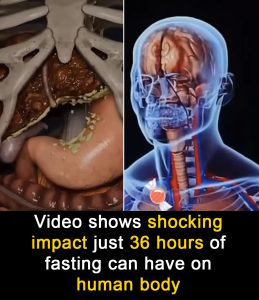The human body is an incredible machine, capable of adapting to a wide range of conditions. One of the most fascinating responses it has is to fasting. When you stop eating for an extended period—say, 36 hours—the changes your body goes through are far more dramatic than most people realize. Whether for religious purposes, weight loss, or potential health benefits, fasting has drawn increasing attention over recent years. While some are skeptical about its value, others swear by it, saying it improves their mental clarity, helps them lose weight, and resets their overall health.

Fasting isn’t new. Many cultures have practiced it for centuries, often tied to spiritual beliefs or religious rituals. However, modern science has begun to explore the physical effects of fasting with more depth, and new research and simulations have offered detailed insights into what actually happens inside the human body during a fast. According to Medical News Today, when done correctly and safely, fasting can help regulate blood sugar levels and improve insulin sensitivity, making it potentially useful for managing or even preventing conditions like type 2 diabetes.
A recent YouTube video delves into the science behind a 36-hour fast, breaking it down into what occurs inside your body at specific four-hour intervals. These changes are surprisingly intricate and can have long-term impacts on your health—both positive and negative.
At the four-hour mark, your body finishes digesting whatever food is left in your stomach. This stage marks the beginning of the “catabolic phase,” which Dr. Robert Kiltz describes as the time when the body starts to break down larger stored molecules, like carbohydrates and fats, into smaller units that can be used as fuel. Since no new food is entering the system, the body turns to what’s already stored to meet its energy needs.
By the eight-hour point, your blood sugar levels begin to decline. With no fresh glucose from food, the body switches to burning glycogen, a stored form of glucose found in the liver and muscles. This marks the body’s first step away from dependence on immediate food sources and into a more self-sustaining energy mode.
Twelve hours into the fast, those glycogen stores are nearly depleted. This is when something known as “metabolic switching” occurs. Your liver starts breaking down stored fat into fatty acids, which are then converted into molecules called ketones. These ketones are used by your brain and muscles for energy. This is also the phase that kick-starts weight loss, as your body is no longer relying on sugar and instead taps into fat reserves.
At the 16-hour mark, a vital cellular process called autophagy begins. According to the Cleveland Clinic, autophagy is when the body’s cells start to clean themselves up, getting rid of damaged components and recycling them into parts that are still useful. This self-renewing process has been associated with a number of health benefits, including improved cellular health and potentially even increased longevity.
Once you hit 24 hours, your body shifts into an even more intense repair mode. Inflammation begins to decrease, and your insulin sensitivity improves, which means your body becomes more efficient at processing sugar. You’re still burning fat at this point, and your body continues to use ketones as its primary energy source. This phase is often seen as one of the most beneficial aspects of a prolonged fast.
By the time you reach 30 hours, levels of human growth hormone in your body spike. This hormone is critical for maintaining muscle mass and promoting fat loss. Some experts suggest that this period is when “deep healing” begins, as the body focuses on preserving lean tissue while continuing to eliminate fat. For those pursuing fitness goals or healing from inflammation-related conditions, this stage can be especially impactful.
Then comes the 36-hour mark—the moment when maximum autophagy takes place. Your body becomes highly efficient at regenerating tissue, recycling cellular waste, and boosting your metabolism. Some advocates of fasting say that this is when you can truly feel the reset happening in your system. You may notice sharper mental clarity, better digestion, and an overall sense of well-being.
In some cases, people continue fasting beyond 36 hours, with some protocols lasting up to 72 hours or even longer. However, extended fasting should only be done under medical supervision, as it carries greater risks and requires careful planning.
Despite the growing popularity of intermittent and prolonged fasting, the scientific community remains divided. James Betts, a professor of metabolic physiology, points out that while there are many proposed benefits of running on fats instead of sugars, most of the available research has not been conducted in humans or hasn’t shown dramatic short-term health improvements. In his words, “We don’t see dramatic health benefits, certainly in the short term.”
Fasting isn’t without its risks. According to a study mentioned by News In Health, people who fast for 16 or more hours a day on a regular basis may have an increased risk of developing gallstones. Common side effects of fasting include intense hunger, food cravings, irritability, low moods, and digestive issues. These symptoms vary from person to person, and for some, they may outweigh the potential benefits.
Ultimately, the effects of fasting depend on many factors, including your age, current health status, lifestyle, and how often or how long you fast. While some people may feel rejuvenated and energized after a fast, others might feel weak and fatigued. That’s why it’s always best to consult with a healthcare provider before starting any fasting regimen. They can help you determine whether fasting is safe and appropriate for your individual needs.
So, while fasting might not be a one-size-fits-all solution, it does offer some compelling insights into how our bodies work and how we can potentially optimize our health. If approached mindfully and with proper guidance, fasting could be more than a trend—it might be a powerful tool for improving well-being.





